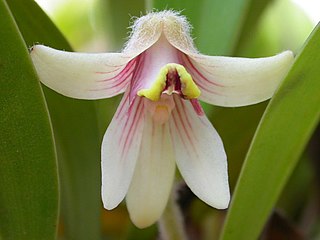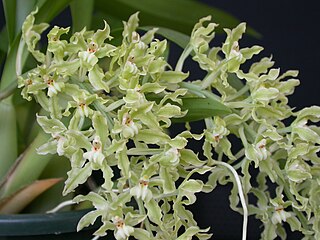
In the botanical classification of plants, Aeridinae Pfitzer is a subtribe of the tribe Vandeae whose representatives all have a monopodial growth habit and do not possess pseudobulbs.

Aerides, known commonly as cat's-tail orchids and fox brush orchids, is a genus belonging to the orchid family. It is a group of tropical epiphyte orchids that grow mainly in the warm lowlands of tropical Asia from India to southern China to New Guinea. They are valued in horticulture for their racemes of showy, fragrant, colorful flowers.

Stanhopea is a genus of the orchid family (Orchidaceae) from Central and South America. The abbreviation used in horticultural trade is Stan. The genus is named for the 4th Earl of Stanhope (1781-1855), president of the Medico-Botanical Society of London (1829-1837). It comprises 55 species and 5 natural hybrids. These epiphytic, but occasionally terrestrial orchids can be found in damp forests from Mexico to Trinidad to NW Argentina. Their ovate pseudobulbs carry from the top one long, plicate, elliptic leaf.

Schomburgkia was a genus of plants belonging to the family Orchidaceae. This genus was named for Richard Schomburgk, a German botanist who explored British Guiana during the 19th century. Former species of this genus were either epiphytic or lithophytic in their growth habit. According to the Royal Horticultural Society Schom. was the official abbreviation for this genus.

Within the Orchidaceae, Hormidium was originally a subgenus of the genus Epidendrum, but was later raised to a full genus. It is now considered not to be distinct from the genus Prosthechea, of which it is a synonym. Most of the species of Hormidium have been transferred to Prosthechea, although others are now classified in Encyclia, Epidendrum, Homalopetalum, and Lepanthes.

Specklinia is a genus of orchids native to South America, Central America, and the Caribbean. It contains approximately 100 species.

Lycaste, abbreviated as Lyc. in horticultural trade, is a genus of orchids that contains about 30 species with egg-shaped pseudobulbs and thin, plicate (pleated) leaves.

Trichosalpinx, commonly known as the bonnet orchid, is a genus of about 100 species of neotropical orchid. The genus is widespread across most of Latin America from northern Mexico to Bolivia, as well as the West Indies.

Campanulorchis is a genus of orchids. It was considered a synonym of the genus Eria, but eventually it has become an accepted name. It is native to Southeast Asia from Hainan to New Guinea.
Cyrtochilum is a genus of flowering plant in the family Orchidaceae, native to the Caribbean and to South America from Costa Rica to Peru. The genus was established by Carl Sigismund Kunth in 1978.

The genus Arachnis, abbreviated as Arach in horticultural trade, is a member of the orchid family (Orchidaceae), consisting of more than 20 species native to China, India, Southeast Asia, Indonesia, the Philippines, New Guinea, and the Solomon Islands.

Ida locusta, synonyms including Sudamerlycaste locusta, is a species of flowering plant in the family Orchidaceae.

Lycaste aromatica, common name the sweet scented lycaste, is a species of flowering plant in the genus Lycaste of the family Orchidaceae.

Brachycorythis is a genus of flowering plants from the orchid family, Orchidaceae. It contains approximately 40-50 species native mostly to Africa and Madagascar but also some from South and East Asia.

Dimorphorchis is a genus of flowering plants from the orchid family, Orchidaceae. It contains 9 species, which are native to Papua New Guinea, the Philippines, Indonesia, Malaysia, Solomon Islands, and Brunei.

Gomesa is a genus of flowering plants from the orchid family, Orchidaceae. It contains about 80–100 species, all native to South America. The genus is abbreviated as Gom.

Maxillariinae is an orchid subtribe in the tribe Cymbidieae. It was formerly treated as the tribe Maxillarieae, and divided into a number of subtribes.

Symphyotrichum oolentangiense, commonly known as skyblue aster and azure aster, is a species of flowering plant in the family Asteraceae native to eastern North America.
















